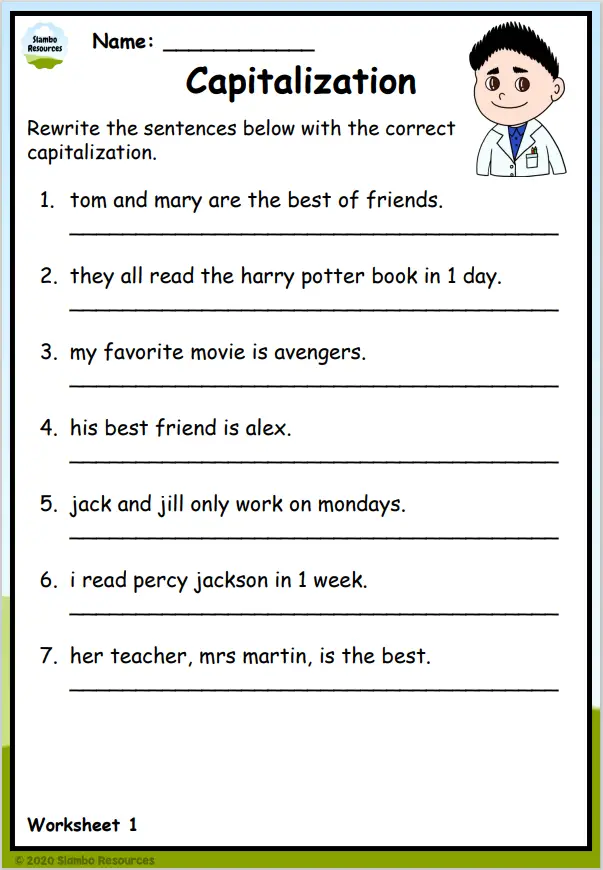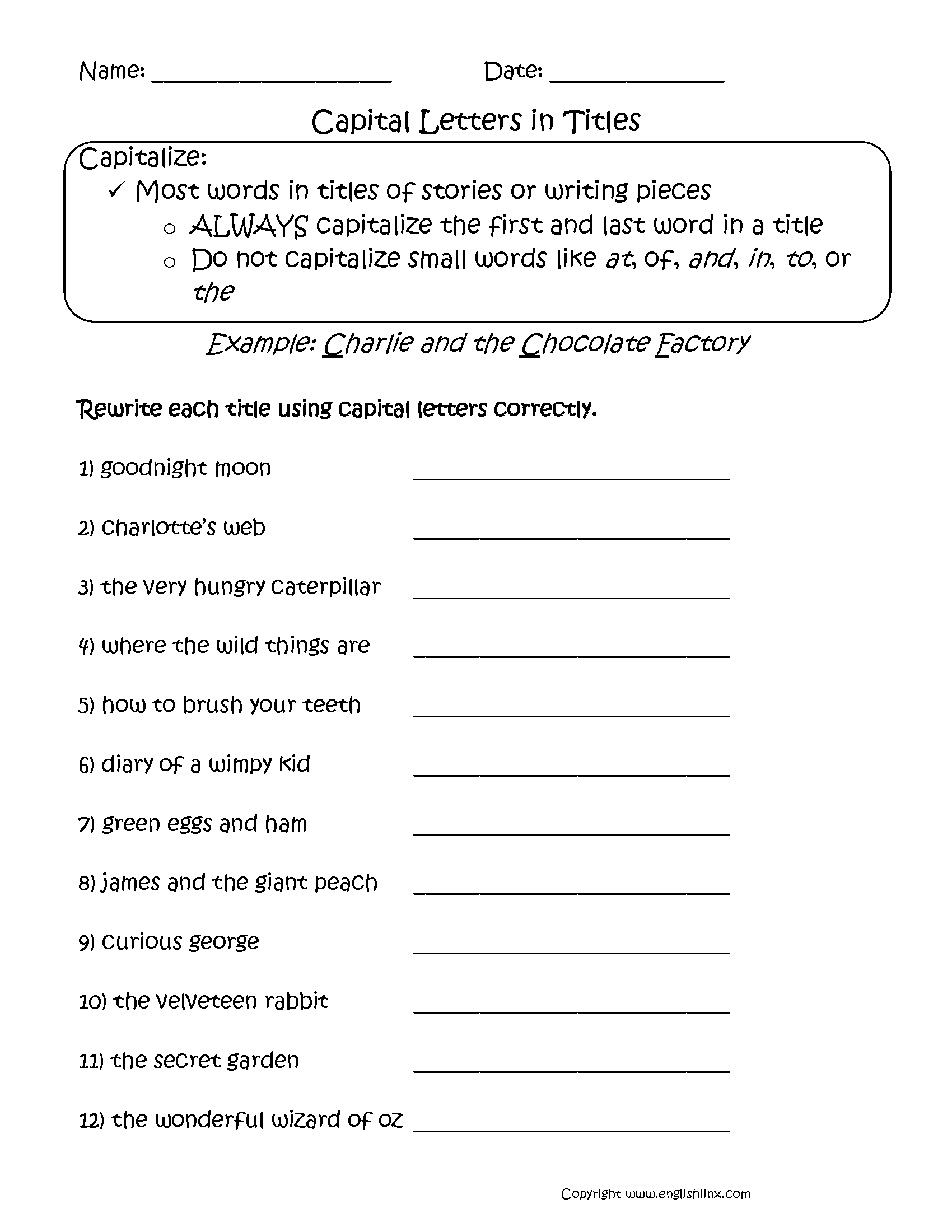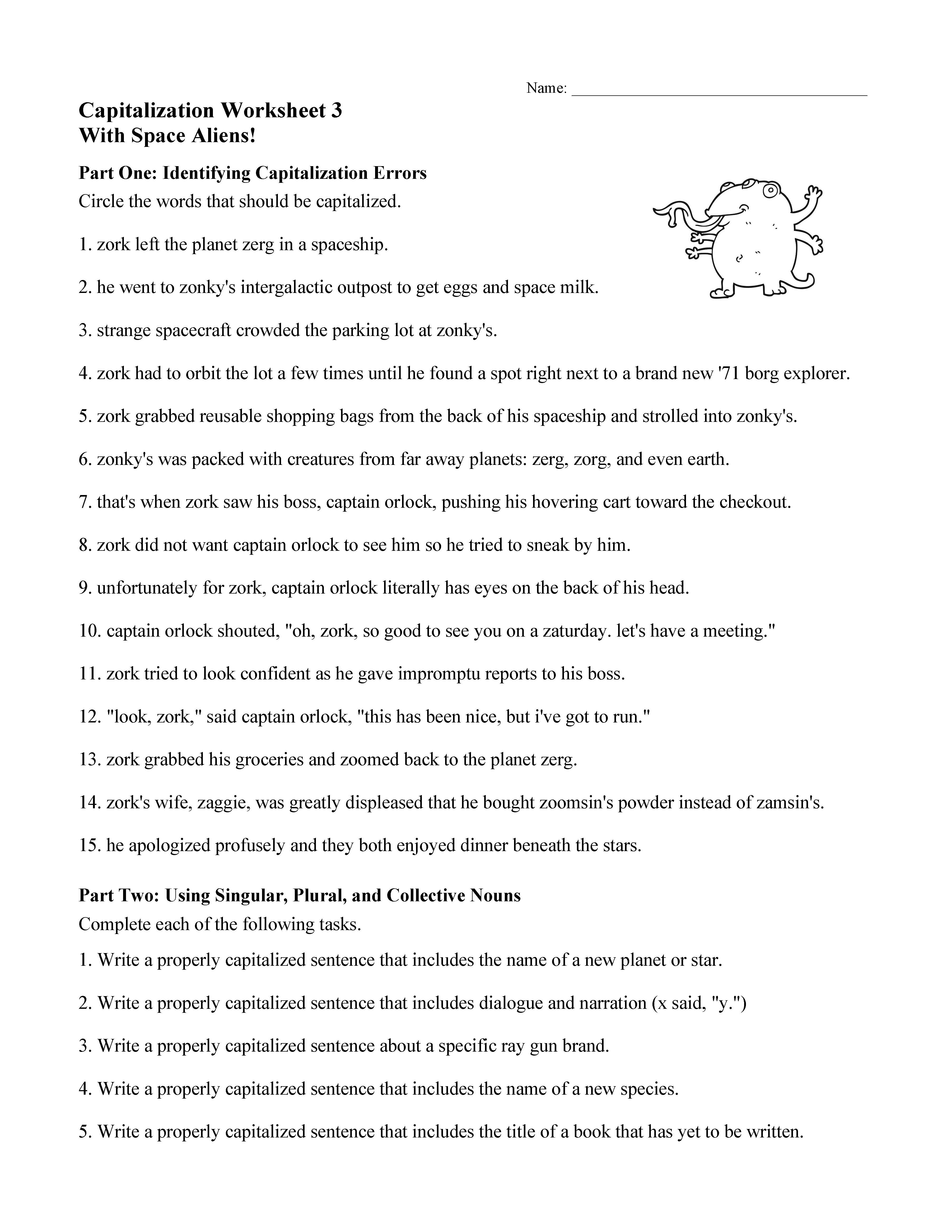
Mastering the Uppercase: The Indispensable Role of Capitalization Worksheets
In the intricate tapestry of the English language, capitalization stands as a fundamental pillar, guiding readers through the structure and meaning of written communication. Far more than just an arbitrary rule, proper capitalization ensures clarity, professionalism, and adherence to grammatical conventions. Yet, for many learners, from young children just beginning their linguistic journey to adults mastering English as a second language, the rules of capitalization can be a labyrinth of exceptions and nuances. This is where capitalization worksheets emerge as invaluable tools, providing structured practice and systematic reinforcement of these essential grammar skills.
The Foundational Importance of Capitalization
Before delving into the specifics of capitalization worksheets, it’s crucial to understand why this grammatical element holds such weight. Capitalization serves several critical functions:

- Signaling the Start of Sentences: The most basic rule, capitalizing the first word of every sentence, provides a clear visual cue to the reader, indicating where one thought ends and another begins. Without it, text would appear as a continuous, overwhelming stream.
- Distinguishing Proper Nouns: Capital letters are the visual markers that differentiate specific people, places, organizations, and unique entities from common nouns. For instance, "river" is a common noun, but "Nile River" is a specific proper noun that requires capitalization. This distinction is vital for precision and avoiding ambiguity.
- Indicating Titles and Specific Events: Whether it’s the title of a book, a movie, a song, a person’s formal title (e.g., Doctor Smith), or a specific historical event (e.g., World War II), capitalization lends respect and specificity to these important designations.
- Enhancing Readability and Professionalism: Correct capitalization makes text easier to read and comprehend. It reflects attention to detail and a command of the language, which is crucial for academic success, professional communication, and effective expression in all written forms. Errors in capitalization can distract readers, convey carelessness, and even alter the intended meaning of a text.




Given this foundational importance, it’s clear why dedicated practice is essential. This is precisely the gap that capitalization worksheets fill, offering a focused and repetitive approach to mastering these critical rules.
What Exactly Are Capitalization Worksheets?
At their core, capitalization worksheets are structured exercises designed to help learners identify, apply, and reinforce the rules of capitalization. They come in a myriad of formats, catering to different learning styles and levels of proficiency. Typically, these worksheets present sentences, paragraphs, or lists of words where capitalization errors are present, or where the learner must apply the correct capitalization.

The design of these worksheets is often progressive, starting with very basic rules and gradually introducing more complex scenarios. This allows learners to build a solid foundation before tackling more intricate applications, preventing overwhelm and fostering a sense of accomplishment as they master each rule.
Key Capitalization Rules Addressed by Worksheets

Effective capitalization worksheets will systematically cover the primary rules of capitalization. A comprehensive set of worksheets would likely include exercises focusing on:
- Beginning of Sentences: Simple exercises where learners capitalize the first word of given sentences.
- Example: the dog barked loudly. becomes The dog barked loudly.

- Proper Nouns:
- Names of People: John, Sarah, President Lincoln.
- Specific Places: Paris, Mount Everest, Atlantic Ocean, Main Street.
- Nationalities, Languages, Religions: American, Spanish, Christianity.
- Specific Organizations and Institutions: United Nations, Harvard University, General Motors.
- Specific Brands and Products: Coca-Cola, iPhone, Nike.
- Titles of Works: Books, movies, songs, articles, poems, and other creative works (e.g., To Kill a Mockingbird, Star Wars, "Bohemian Rhapsody").
- Days of the Week, Months, and Holidays: Monday, December, Christmas, Thanksgiving.
- Geographical Features: Rivers, mountains, deserts, valleys (when part of a proper name).
- Historical Periods and Events: The Renaissance, the Civil War, the Industrial Revolution.
- Abbreviations and Acronyms: NASA, FBI, USA, PhD.
- The Pronoun "I": Always capitalized, regardless of its position in the sentence.
- Titles of People: When used with a name (e.g., Doctor Evans, Professor Jones, Queen Elizabeth).

By isolating these rules and providing ample opportunities for practice, worksheets help learners internalize the conventions, making correct capitalization an automatic process rather than a constant struggle.
Diverse Types of Capitalization Worksheets
The versatility of capitalization worksheets is one of their greatest strengths. They can be designed in numerous formats to keep learning engaging and address different skill sets:
- "Fix the Sentence" Worksheets: Learners are given sentences with capitalization errors and must rewrite them correctly. This is perhaps the most common and effective type, as it requires active correction.
- "Identify the Error" Worksheets: Students underline or circle the words that need capitalization in a given paragraph or list of sentences. This type focuses on recognition skills.
- "Fill-in-the-Blank" Worksheets: Sentences are provided with blanks where proper nouns or specific titles should be inserted, requiring the student to not only recall the word but also capitalize it correctly.
- "Categorization" Worksheets: Learners are given a list of words and must sort them into categories (e.g., "Needs Capitalization," "Does Not Need Capitalization," or categories based on why it needs capitalization, like "Proper Noun," "Start of Sentence").
- "Multiple Choice" Worksheets: Students select the correctly capitalized option from a set of choices. While less active, this can be useful for quick assessments or as a warm-up.
- "Creative Writing Prompts": More advanced worksheets might provide a prompt or a picture, asking students to write a short paragraph, explicitly instructing them to pay attention to capitalization. This integrates the skill into a more comprehensive writing task.
- Digital vs. Printable: Many worksheets are available in printable PDF formats, perfect for classroom use or at-home practice. Increasingly, interactive digital worksheets are also available, offering immediate feedback and often gamified elements, which can be particularly engaging for tech-savvy learners.
The Multifaceted Benefits of Using Capitalization Worksheets
The strategic use of capitalization worksheets offers a wealth of benefits for learners of all ages and proficiency levels:
- Targeted Practice: Worksheets allow learners to focus specifically on capitalization rules without being overwhelmed by other grammatical concepts. This isolation helps in solidifying understanding.
- Reinforcement and Repetition: Mastery of grammar often comes through consistent practice. Worksheets provide the necessary repetition to move rules from conscious effort to automatic application.
- Identification of Weak Areas: By reviewing completed worksheets, educators and learners can quickly identify which capitalization rules are most challenging, allowing for targeted re-teaching or additional practice.
- Building Confidence: Successfully completing exercises builds a learner’s confidence in their grammatical abilities, encouraging them to tackle more complex writing tasks.
- Independent Learning: Many worksheets are designed for independent completion, fostering self-reliance and allowing learners to progress at their own pace.
- Foundation for Advanced Writing: A strong grasp of capitalization is a prerequisite for effective and sophisticated writing. By mastering this basic skill, learners are better equipped to focus on sentence structure, vocabulary, and rhetorical devices.
- Diagnostic Tool for Educators: Teachers can use worksheets not only for practice but also as diagnostic tools to assess current understanding and plan future lessons.
- Engaging Learning: When designed well, with varied formats, relevant content, and clear instructions, worksheets can make learning capitalization an engaging and even enjoyable process, rather than a tedious chore.
Maximizing the Effectiveness of Capitalization Worksheets
To get the most out of capitalization worksheets, consider these best practices:
- Start Simple and Progress Gradually: Begin with the most basic rules (e.g., capitalizing the first word of a sentence, names of people) and gradually introduce more complex concepts.
- Provide Clear Instructions and Examples: Before students begin, ensure they understand the task and provide one or two completed examples.
- Offer Immediate Feedback: Correcting errors promptly helps solidify the correct rule. This can be done by a teacher, a parent, or through self-correction with an answer key.
- Integrate with Other Grammar Lessons: While worksheets focus on capitalization, remind students how this skill fits into the broader context of sentence structure, punctuation, and overall writing.
- Connect to Real-World Writing: Encourage students to look for examples of correct capitalization in books, articles, and everyday text. Have them apply the rules in their own creative writing or journal entries.
- Make it Fun: Incorporate games, challenges, or themed worksheets (e.g., holiday-themed capitalization, capitalization for a specific subject like science or history) to maintain interest.
- Regular, Short Practice Sessions: Rather than long, infrequent sessions, short, consistent practice with worksheets is often more effective for long-term retention.
- Review and Revisit: Periodically revisit previously covered rules to ensure they are retained, especially those that were initially challenging.
Conclusion
In the journey toward mastering written English, capitalization is a fundamental milestone. While it may seem like a minor detail, its correct application profoundly impacts the clarity, professionalism, and effectiveness of communication. Capitalization worksheets are far more than mere drills; they are indispensable tools that provide the structured, targeted, and repetitive practice necessary for learners to internalize these crucial grammatical rules.
From distinguishing proper nouns to signaling the start of a new thought, capitalization empowers writers to convey their messages with precision and confidence. By systematically working through well-designed capitalization worksheets, learners can overcome common hurdles, build a strong foundation in grammar, and ultimately unlock their full potential as articulate and effective communicators in the English language. Embracing these worksheets as a core component of language instruction is a vital step towards achieving grammatical excellence.
